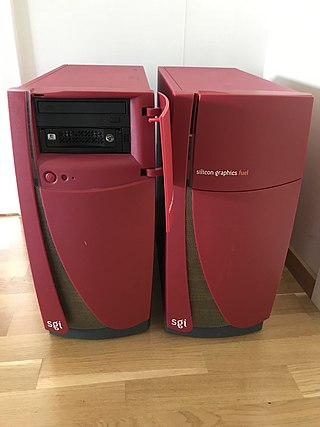
A motherboard is the main printed circuit board (PCB) in general-purpose computers and other expandable systems. It holds and allows communication between many of the crucial electronic components of a system, such as the central processing unit (CPU) and memory, and provides connectors for other peripherals. Unlike a backplane, a motherboard usually contains significant sub-systems, such as the central processor, the chipset's input/output and memory controllers, interface connectors, and other components integrated for general use.

Silicon Graphics, Inc. was an American high-performance computing manufacturer, producing computer hardware and software. Founded in Mountain View, California, in November 1981 by James Clark, its initial market was 3D graphics computer workstations, but its products, strategies and market positions developed significantly over time.

The SGI Indigo2 and the SGI Challenge M are Unix workstations which were designed and sold by SGI from 1992 to 1997.

The DECstation was a brand of computers used by DEC, and refers to three distinct lines of computer systems—the first released in 1978 as a word processing system, and the latter two both released in 1989. These comprised a range of computer workstations based on the MIPS architecture and a range of PC compatibles. The MIPS-based workstations ran ULTRIX, a DEC-proprietary version of UNIX, and early releases of OSF/1.

The Octane series of IRIX workstations was developed and sold by SGI in the 1990s and 2000s. Octane and Octane2 are two-way multiprocessing-capable workstations, originally based on the MIPS Technologies R10000 microprocessor. Newer Octanes are based on the R12000 and R14000. The Octane2 has three improvements: a revised power supply, system board, and Xbow ASIC. The Octane2 has VPro graphics and supports all the VPro cards. Later revisions of the Octane include some of the improvements introduced in the Octane2. The codenames for the Octane and Octane2 are "Racer" and "Speedracer" respectively.

The Indy, code-named "Guinness", is a low-end multimedia workstation introduced on July 12, 1993 by Silicon Graphics Incorporated (SGI). SGI developed, manufactured, and marketed Indy as the lowest end of its product line, for computer-aided design (CAD), desktop publishing, and multimedia markets. It competed with Intel x86 computers, and with Windows and Macintosh, including using their files and running their applications via software emulation. It is the first computer to come standard with a video camera, called IndyCam.

The SGI Fuel is a mid-range workstation developed and manufactured by Silicon Graphics, Inc. (SGI). It was introduced in January 2002, with a list price of US$11,495. Together with the entire MIPS platform, general availability for the Fuel ended on December 29, 2006. An equivalent product for the same market segment was not provided until 2008, when the Virtu product line was introduced, based on x86 microprocessors and Nvidia graphics.

The SGI Tezro is a series of high-end computer workstations sold by SGI from 2003 until 2006. Using MIPS CPUs and running IRIX, it is the immediate successor to the SGI Octane line. The systems were produced in both rack-mount and tower versions, and the series was released in June 2003 with a list price of US$20,500. The Tezro was released alongside the SGI Onyx 4 and rack-mountable Tezros share many components with it, including plastic skins. The rack-mounted Tezros are functionally very similar to an Infinite Performance-equipped SGI Onyx350. Tezro marked the return of the original cube logo to SGI machines.
XIO is a packet-based, high-performance computer bus employed by the SGI Origin 2000, Octane, Altix, Fuel and Tezro machines. The XIO forms a bus between high-performance system devices and the memory controller.

The O2 is an entry-level Unix workstation introduced in 1996 by Silicon Graphics, Inc. (SGI) to replace their earlier Indy series. Like the Indy, the O2 uses a single MIPS microprocessor and was intended to be used mainly for multimedia. Its larger counterpart is the SGI Octane. The O2 was SGI's last attempt at a low-end workstation.

Altix is a line of server computers and supercomputers produced by Silicon Graphics, based on Intel processors. It succeeded the MIPS/IRIX-based Origin 3000 servers.

SGI Visual Workstation is a series of workstation computers that are designed and manufactured by SGI. Unlike its other product lines, which used the 64-bit MIPS RISC architecture, the line used Intel Pentium II and III processors and shipped with Windows NT 4.0 or Windows 2000 as its operating system instead of IRIX. However, the Visual Workstation 320 and 540 models deviated from the architecture of IBM-compatible PCs by using SGI's ARCS firmware instead of a traditional BIOS, internal components adapted from its MIPS-based products, and other proprietary components that made them incompatible with internal hardware designed for standard PCs and hence unable to run other versions of Microsoft Windows, especially Windows 9x. By contrast, the remaining models in the line are standard PCs, using VIA Technologies chipsets, Nvidia video cards, and standard components.

The Indigo, introduced as the IRIS Indigo, is a line of workstation computers developed and manufactured by Silicon Graphics, Inc. (SGI). SGI first announced the system in July 1991.
The SGI Origin 350 is a mid-range server computer developed and manufactured by SGI introduced in 2003. Their discontinuation in December 2006 brought to a close almost two decades of MIPS and IRIX computing.
The Challenge, code-named Eveready and Terminator, is a family of server computers and supercomputers developed and manufactured by Silicon Graphics in the early to mid-1990s that succeeded the earlier Power Series systems. The Challenge was later succeeded by the NUMAlink-based Origin 200 and Origin 2000 in 1996.

The SGI Origin 2000 is a family of mid-range and high-end server computers developed and manufactured by Silicon Graphics (SGI). They were introduced in 1996 to succeed the SGI Challenge and POWER Challenge. At the time of introduction, these ran the IRIX operating system, originally version 6.4 and later, 6.5. A variant of the Origin 2000 with graphics capability is known as the Onyx2. An entry-level variant based on the same architecture but with a different hardware implementation is known as the Origin 200. The Origin 2000 was succeeded by the Origin 3000 in July 2000, and was discontinued on June 30, 2002.
The Origin 3000 and the Onyx 3000 is a family of mid-range and high-end computers developed and manufactured by SGI. The Origin 3000 is a server, and the Onyx 3000 is a visualization system. Both systems were introduced in July 2000 to succeed the Origin 2000 and the Onyx2 respectively. These systems ran the IRIX 6.5 Advanced Server Environment operating system. Entry-level variants of these systems based on the same architecture but with a different hardware implementation are known as the Origin 300 and Onyx 300. The Origin 3000 was succeeded by the Altix 3000 in 2004 and the last model was discontinued on 29 December 2006, while the Onyx 3000 was succeeded by the Onyx4 and the Itanium-based Prism in 2004 and the last model was discontinued on 25 March 2005.

InfiniteReality refers to a 3D graphics hardware architecture and a family of graphics systems that implemented the aforementioned hardware architecture that was developed and manufactured by Silicon Graphics from 1996 to 2005. The InfiniteReality was positioned as Silicon Graphics' high-end visualization hardware for their MIPS/IRIX platform and was used exclusively in their Onyx family of visualization systems, which are sometimes referred to as "graphics supercomputers" or "visualization supercomputers". The InfiniteReality was marketed to and used by large organizations such as companies and universities that are involved in computer simulation, digital content creation, engineering and research.
The Ultra 60 is a computer workstation in a tower enclosure from Sun Microsystems. The Ultra 60 was launched in November 1997 and shipped with Solaris 7. It was available in several specifications.

On June 26, 2007, Dell released the new Inspiron desktop series, under the Dell Inspiron branding, as a replacement to the Dell Dimension desktop computers.














